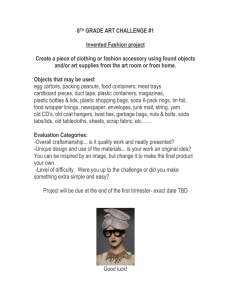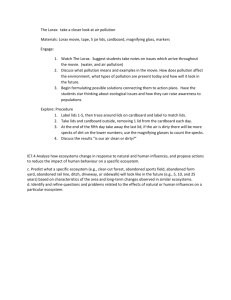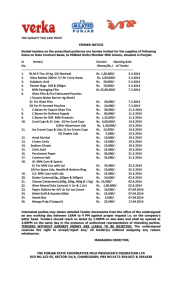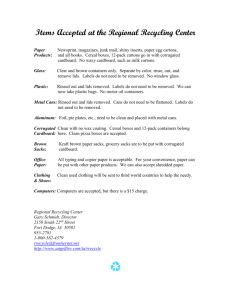TRASH TO TREASURE
advertisement
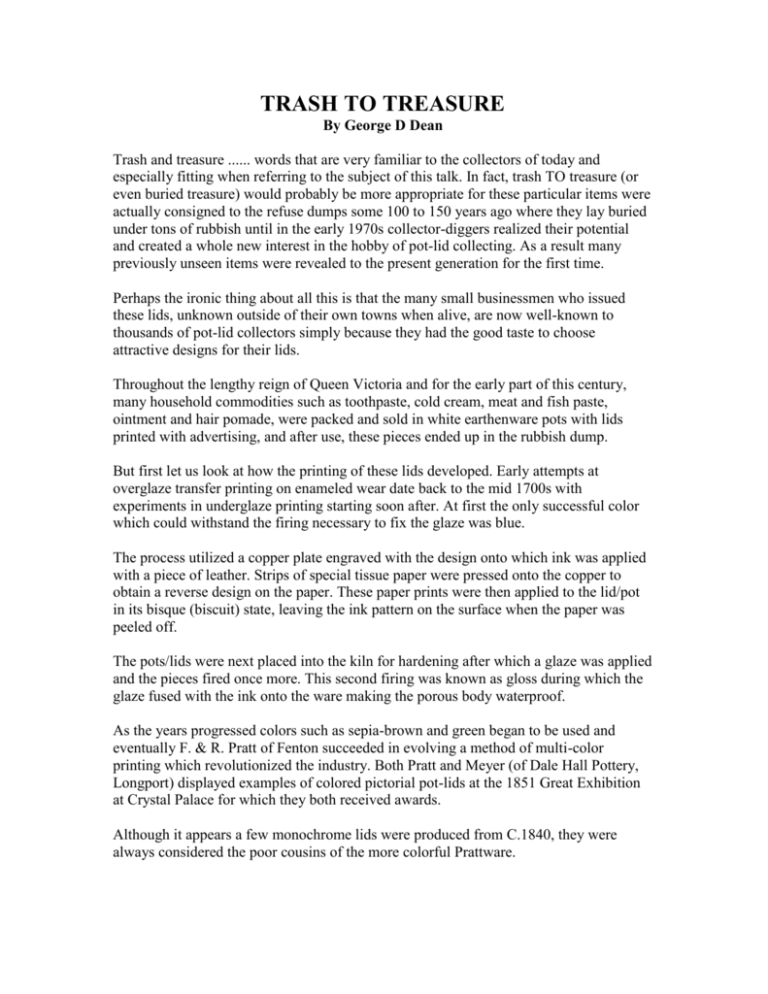
TRASH TO TREASURE By George D Dean Trash and treasure ...... words that are very familiar to the collectors of today and especially fitting when referring to the subject of this talk. In fact, trash TO treasure (or even buried treasure) would probably be more appropriate for these particular items were actually consigned to the refuse dumps some 100 to 150 years ago where they lay buried under tons of rubbish until in the early 1970s collector-diggers realized their potential and created a whole new interest in the hobby of pot-lid collecting. As a result many previously unseen items were revealed to the present generation for the first time. Perhaps the ironic thing about all this is that the many small businessmen who issued these lids, unknown outside of their own towns when alive, are now well-known to thousands of pot-lid collectors simply because they had the good taste to choose attractive designs for their lids. Throughout the lengthy reign of Queen Victoria and for the early part of this century, many household commodities such as toothpaste, cold cream, meat and fish paste, ointment and hair pomade, were packed and sold in white earthenware pots with lids printed with advertising, and after use, these pieces ended up in the rubbish dump. But first let us look at how the printing of these lids developed. Early attempts at overglaze transfer printing on enameled wear date back to the mid 1700s with experiments in underglaze printing starting soon after. At first the only successful color which could withstand the firing necessary to fix the glaze was blue. The process utilized a copper plate engraved with the design onto which ink was applied with a piece of leather. Strips of special tissue paper were pressed onto the copper to obtain a reverse design on the paper. These paper prints were then applied to the lid/pot in its bisque (biscuit) state, leaving the ink pattern on the surface when the paper was peeled off. The pots/lids were next placed into the kiln for hardening after which a glaze was applied and the pieces fired once more. This second firing was known as gloss during which the glaze fused with the ink onto the ware making the porous body waterproof. As the years progressed colors such as sepia-brown and green began to be used and eventually F. & R. Pratt of Fenton succeeded in evolving a method of multi-color printing which revolutionized the industry. Both Pratt and Meyer (of Dale Hall Pottery, Longport) displayed examples of colored pictorial pot-lids at the 1851 Great Exhibition at Crystal Palace for which they both received awards. Although it appears a few monochrome lids were produced from C.1840, they were always considered the poor cousins of the more colorful Prattware. The earliest pot-lids were handmade with the help of tools, and all these early lids, prior to about 1860, had flat tops. During the 1860s more mechanized methods of manufacturing pots and lids were introduced, and they were molded, usually in plaster moulds. From this time onwards, lids were to be found with domed tops. The majority of pot-lids have a profile which conforms closely to one of six or seven basic shapes. Slight variations may be evident due to the amount of care taken during molding and the interpretation of mould shapes between the different potters. The choice of profile, in general, was as a result of both practical and aesthetic considerations. For the first thirty years of the use of printed pot-lids, most were round in shape. From the late 1870s, but mainly in the '80s, rectangular lids became popular. Also tried were oval-shaped pots and lids, but because these were difficult to pack and store did not become popular. While some manufacturers secured the contents by means of a paper label around the base and lid, others employed the Toogood patent whereby grooves were provided on opposite sides of the lid and base through which string was passed to secure the two parts and contents within. The use of lids with paper labels prevailed until around mid-century by which time there was a gradual acceptance of the fact that the more permanent effect of a printed advertisement, protected underneath the glaze, was worthy of the additional expense. Paper labels on lids were easily defaced or destroyed by the time toothpaste or cream was consumed, and the underglaze printing could survive any kind of treatment and pieces could even be reused. Some pot-lids have one or more gold bands added over the glaze and are found mainly from 1880-1910. These appear normally on dome-shaped lids. Pot-lids for bear's grease, an early form of perfumed hair grease, although not always the most attractive of lids, are certainly considered the most desirable by many collectors. Bear's grease was popular in England from the seventeenth century and claims for its efficacy in promoting a healthy growth of hair were widely believed. It is doubtful that there was any truth in these claims, but it is absolutely certain that bears have never appeared to suffer from baldness. The fashion of wig-wearing, imported from France, was widespread in the seventeenth and eighteenth centuries, but after the French Revolution made the wearing of powdered wigs unpopular, men grew their natural hair long and bunched at the back. It was often powdered by the gentlemen of the day - with blue powder from about 1770 and later with red powder. When a tax was imposed on this powder in 1845, there was an outcry against this, and from that date onwards the use of bear's grease and other pomade became popular. A pomade is a scented ointment, originally used on the face, but by the eighteenth century was more often used on the skin of the head and on the hair. Throughout the period of its popularity, the high price of bear's grease must have restricted its use to the more affluent members of society. Many thousands of bears were killed in the production of hair grease. It was usually the brown Russian bears which were exploited although the Canadian black bear was used and occasionally polar bears. It is also known that reindeer and buffalo grease were used and one lid displays a picture of a lion. It's hard to imagine the king of beasts being used for this purpose. Whilst bear's grease was becoming unpopular by the 1880s, pomades continued to be used up to about 1900 or slightly after. These preparations eventually were sold in liquid form in bottles for which all Russian bears must be forever grateful. Toothpaste was by far the most popular commodity sold in pots with printed labels. Interest in keeping the teeth clean was only aroused in the seventeenth century and escalated during the eighteenth. At this time, dentifrice was sold as a powder. In Georgian times, the poor rubbed salt on their teeth, but many people made up their own recipes and rubbed the powder on their teeth with a toothstick with a rag over the end - a forerunner of the toothbrush - which became popular when the more solid toothpaste or tooth soap came into general use in the early nineteenth century. Toothpaste was sold in pots until the commencement of the 1914 war. Practically every small chemist made his own paste and had his own personalized printed lids. The two most popular types of toothpaste lids are for areca nut and cherry tooth paste. Oddly both were made to the same formula, i.e. with areca nut flavoring, but the cherry tooth paste was cherry colored by the addition of carmine. Nothing was added to give a cherry flavor, the description "cherry" being applied merely due to the color the paste. The addition of Indian areca or betel nut and of the cherry coloring suggested attractive pictorial adornment for the lids. Areca nuts were normally used as a worming agent and no doubt few realized they were being mildly wormed when they cleaned their teeth. By 1915 most manufacturers had changed over to metallic tubes. With the exception of toothpaste, the lids of cold cream pots were the most numerous and there are many attractive lids, often embellished with floral borders or with bouquets of flowers. Like toothpaste, cold cream continued to be sold in printed pots up to the commencement of the 1914 war, when, as with most pot-lids, they were discontinued, giving way to more economical forms of packaging such as tins or waxed cardboard boxes. Victorian ointment producers were responsible for the existence of historically interesting pot-lids. This was the era of the so-called elixir or cure-all whose advertisers recognized no boundaries. People of the day would grasp at any means of combating diseases such as typhoid, dysentery, diphtheria, etc. One of the most notable ointment vendors was "Professor" Thomas Holloway who was equally famous for his pills. An advertisement which appeared in Punch in 1843 stated, "Mr. Holloway declares that his famous ointment will mend the legs of men and tables equally well and is an excellent relish for frying fish in." As ointments were supposed to have some medicinal powers, they were subjected to a government-imposed duty of 1/½d. on the 1/- pots and pro rata for the larger sizes. A surprising number of Australian lids are for medicinal ointment, a fact possibly due to the lack of doctors in the outback. From the study of pot-lids, the tastes of our Victorian and Edwardian ancestors can be observed. The most noticeable factor is their predilection for bloater and anchovy pastes. Edible paste pot-lids are mainly from the latter part of the pot-lid period, most from 1890-1910. Lip salve was sold in very small pots in the 1870s and '80s. Artistically lip salve lids generally lack eye appeal as being so small they present little space for anything save the commodity name and sometimes the name of the chemist and of the town. The same applies to eye ointment. Shaving cream was another commodity sold in pots. This was of a creamy texture, similar to the modern product, but the more solid sticks had practically replaced the pots by about 1920. An Australian branded pot-lid is simply one which has printed on it the name of an Australian town, chemist or company. Only a few of the thousands of pharmacies in Australia in the late 1800s packaged their products in personally branded pots. It was often more economical for a pharmacist to buy in branded pots from an English pharmaceutical company, complete with contents. Most Australian branded pot-lids were actually made in England, the consignment then shipped to the Australian chemist who would place in the contents, either to his own formula, or the product of some large Australian manufacturer. The blue and brown Trouchets Corn Cure lids are strongly rumored to have been manufactured in Adelaide. In every town in Australia lies a site used during last century for the disposal of household refuse. The better dumps to try looking for lids are the ones in use from 18801910. As pharmaceutical lines of large companies were hawked throughout the country, areas where Australian pot-lids could turn up are limitless. Pot-lids found in old rubbish tips are often disfigured with dirt and grime, rust, or burn and soot marks. Removal of these can sometimes be difficult. These impairments on the surface of a pot-lid will detract from its value. Lids which are in perfect condition on the top surface but suffer from damage on the lower rim are still very collectable. It would be interesting to know just how much, if any, of today's refuse will withstand the ravages of time in the manner of the underglazed transfer printed ceramic pot-lids of the past century. Very little I would suggest.

